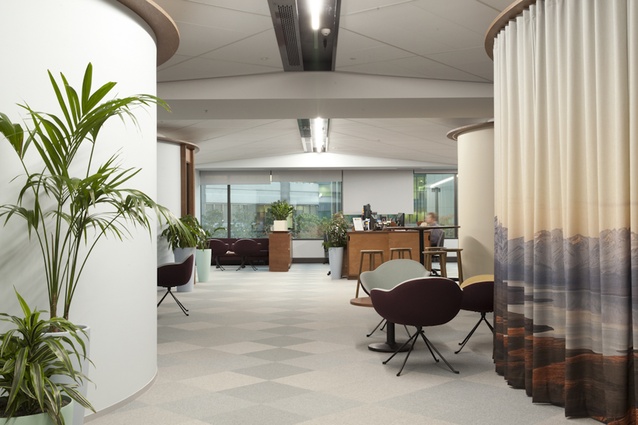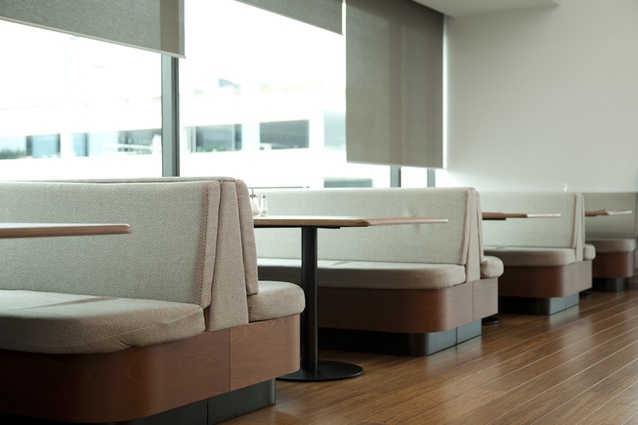Genesis
Genesis Energy’s customers would be familiar with the nostalgic shapes and the retro palette of New Zealand’s yesteryear. Architect Nat Cheshire from Cheshire Architects noticed this connection recently when he visited the station which generates almost 20 per cent of the country’s electricity. He saw an opportunity to exploit the the vernacular of tactility and robustness of mid-century New Zealand design, at the same time engaging in the language of Kiwi domesticity. Combined, these ideas have resulted in a quiet nostalgia in the custom fit-out of Genesis Energy’s new Auckland headquarters located in Greenlane’s Central Park business precinct.
This visual and physical connection between the customer and Genesis Energy’s corporate environment is added to by the use of a gentle palette, which references the idyllic natural environment that envelops the myriad New Zealand power stations run by Genesis Energy. The result is an innovative, serene and gently familiar interior.
Yet only two years ago, Genesis’ headquarters was suffering from a growing disconnection between departments, with teams scattered in different buildings and staff segregated in disconnected silos.
Meeting rooms were sparse and often unavailable due to high demand, and there was a lack of collective space in which to promote connections and collaboration between workers.
When the opportunity arose to take on a new lease 400 metres down the road in a new building, it was vitally important that the custom-designed fit-out address the disunion of corporate divisions.

Cheshire had not designed an office space of any scale before but believes that an outsider’s view brought clarity to creating a solution for the challenging geometry of the new offices, which were completed in October last year.
He reasoned that the way the company had been organised was enforcing a divided way of working – therefore, creating a solution that was “diametrically opposite to that model” was the answer.
The three floors Genesis takes of the four-storeyed building consist of large and generic floor plates, spanning 3,500m2 in total. “Firstly, we needed to interrupt the generic-ness of that shell,” Cheshire says.
The aesthetically challenged grid of columns on each floor is concealed by groups of meeting rooms, many of them in, circular pod-like shapes, with lowered ceilings, forming soft cocooning areas that create a sense of fluidity.
“We tried to introduce an energy into the floor plate wherever we could,” he says.
A wave-shaped ceiling on each floor is one of the many ways in which an energy is brought into the space. It consists of a series of folded plates, which have their apex right up at the underside of the floor above and fold themselves down to slip under the structural beams – not only relieving the oppressive energy of an infinitely flat suspended ceiling, but creating a dynamic space under which to work.
LED lighting forms long narrow lines and the air conditioning, fire protection and other services are intensively coordinated into thin black strips, which fit neatly into the fold line of the ceiling plate which Cheshire likens to a “crisp, folded sheet”.
The cost-efficient carpet tiling interrupts the vast floor plate, forming a herringbone pattern in a series of muted greens and greys; the direction of the pattern is skewed against the flow of the building.
The clusters of annular meeting rooms, at the nucleus of each of the three floors, create nooks and niches for collective space, providing little meeting places and opportunities for collaboration. Images of power stations and their idyllic habitats printed onto curtains, soften the perimeters of some of the meeting rooms, making the most literal connection between the many locations in Genesis’ portfolio and its Auckland headquarters.
The language of the furniture – pairs of linen chairs in retro colours and shapes coupled with spherical pendant lights centred above round wooden tables – suggests comfort and domesticity. High meeting tables in tactile solid wood, paired with stools that reference mid-century engineering workshops sit alongside floor -to-ceiling curved walls – painted in whiteboard paint in order not to interrupt the fluidity of the spaces. Cheshire says the familiar textures, colours and materials have the ability to soften “those long commercial sessions”.
Bespoke timber workstations circumnavigate the meeting rooms on each floor, running in ribbons off the entire perimeter of the building on each floor so natural light is available to all. With Genesis being the largest State-owned enterprise in the country, there were exacting demands on how much impact the new workplace model would have on the company as a whole. The design not only achieves connections and collaboration between staff and customers, but also will eventually unify the company’s many offices as they are gradually assimilated into this new model.
—>














